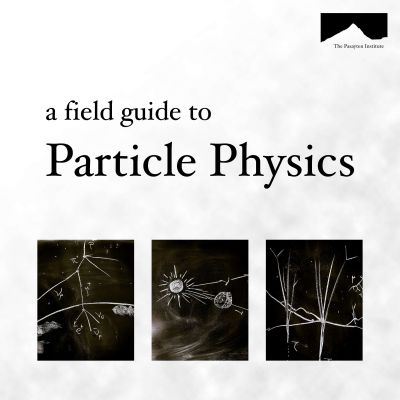This is your informal guide to the subatomic ecosystem we’re all immersed in. In this series, we explore the taxa of particle species and how they interact with one another. Our aim is give us all a better foundation for understanding our place in the universe. The guide starts with a host of different particle species. We’ll talk about their masses, charges and interactions with other particles. We’ll talk about how they are created, how they decay, and what other particles they might be made of.
https://pasayten.org/the-field-guide-to-particle-physics
episode 7: Bonus : The Perils of Science Communication
Update! Best place to find associated references are linked in our substack essay:
This is an essay that we originally posted on our substack page:
https://pasayteninstitute.substack.com/p/the-perils-of-science-communication
A Bonus Episode for The Field Guide to Particle Physics : Season 3
https://pasayten.org/the-field-guide-to-particle-physics
©2022 The Pasayten Institute cc by-sa-4.0
The definitive resource for all data in particle physics is the Particle Data Group: https://pdg.lbl.gov.
The Pasayten Institute is on a mission to build and share physics knowledge, without barriers! Get in touch.
A History Lesson
In the film “Einstein’s Big Idea”, French Scientist Antoine Lavoisier is portrayed just as he discovers how to split water into oxygen and hydrogen gas, thereby realizing the conservation of mass in chemical reactions.
Lavoisier is generally credited with disproving the phlogiston theory of combustion and reframing Chemistry as a quantitive science.
This shift from the qualitative is emphasized in a specific scene where Lavoisier meets with an excited young man who is pitching his apparatus for observing heat. Lavoisier assertively dresses down the man for failing to meet the modern, quantitative standards of scientific experiment.
This man is later revealed to be a revolutionary, and Lavoisier’s final act of the film ends with an escort to the guillotine.
While dramatized, the message was clear:
Science needs popular support, and clear communication is not enough. We need to do more than educate. We need to build community with inspiration, excitement and respect for Science. We also need to share with folks how Science works1.
Respect for Science is a value we share as Scientists. But it’s not universal. Whether or not Science is morally entitled to respect is irrelevant. Without constantly striving to earn and refresh that respect from Society, it can be lost.
The Siren Call of the Outsider
Science Communication is a rapidly professionalizing field that encompasses a spectrum from dynamic professional speakers to university department media managers to science-minded journalists.
From journalists like Natalie Wolchover, to Professors like Tatiana Eurikhamova, there’s a lot of great work being done by people I admire.
The line between #SciComm and marketing is extremely thin, and unfortunately, the internet’s content treadmill incentives their confluence.
Journals and university departments alike publish heroic press-releases about recently accepted scientific publications by department staff as if they were breakthrough results. But more often than not, these results are merely slow, incremental progress.
How is anyone but a specialist supposed to understand the difference?
The SciComm ecosystem, in other words, is full of noise. Especially for the general audience.
Cutting through that noise is tough. But content editors have had a tool for this as long as humans have printed newspapers: headlines.
Here’s a recent one:
“No one in physics dares say so, but the race to invent new particles is pointless.
In private, many physicists admit they do not believe the particles they are paid to search for exist – they do it because their colleagues are doing it”Sabine Hossenfelder - the Guardian Opinion (26 Sept 2022)
As a lead generator, this headline and its subtitle are incredible. Given the current intellectual climate around distrusting experts, it hits all the high points: All these experts have no idea what they’re doing, there’s some structural conspiracy and they’re wasting your money.
Taken with the author’s antagonistic, “outsider” persona2, it's direct aim at an established field of study. It's a recipe for clicks, likes and angry shares.
Unfortunately, the piece willfully and violently mischaracterizes the current state of particle physics. It’s so flagrant - and so short - that it’s worth a read.
A Reading Guide to Hossenfelder’s Complaint
Here is a highlighted list of rhetorical and factual errors which both discredit the thesis of Hossenfelder’s piece and demonstrates its disservice to the endeavor of Science Communication.
Broadly, high energy or “particle” physics is the study of what constitutes matter and energy, as well as the forces that govern their dynamics. Like any good science, it involves the study of both what particles we see as well as how those forces work.
Hossenfelder’s piece begins with a collection of names of physical models at various stages of generality. As written, it conflates them with concrete models for actual, physical particles. Doing so betrays such a misunderstanding of how Particle Physics works in practice that it was almost certainly an editorial decision.
Let’s consider some examples.
The Sfermion
The sfermion is a very broad class of particle, a collective noun akin to saying “cats” or even “mammals”. They are particles associated to fundamental fermions - particles of matter like the electron, muon or up quark - by a general class of models related to the idea of Supersymmetry3. Whence the name s(uper)fermion.
The Magnetic Monopole
Magnetic monopoles are another broad class of particle. An electric monopole is a particle like an electron, proton or even an
